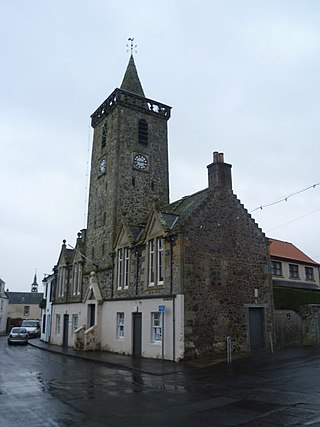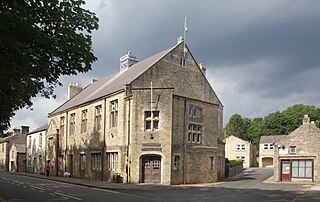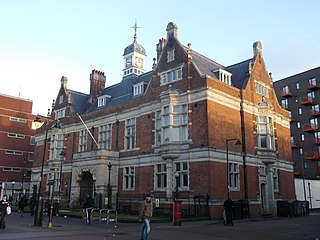
Guiseley Theatre, formerly Guiseley Town Hall, is a municipal building at The Green, Guiseley, West Yorkshire, England. The structure, which was once the headquarters of Guiseley Urban District Council, is now a theatre.

Middlewich Town Hall, also known as Victoria Buildings, is a municipal structure in Lewin Street, Middlewich, Cheshire, England. The building, which was originally commissioned as a technical school and public library, is now the meeting place of Middlewich Town Council.

Egremont Town Hall is a municipal building in Main Street, Egremont, Cumbria, England. The town hall, which is currently used as a public library, is a Grade II listed building.

The Old Town Hall is a building on Church Street in the market town of Poulton-le-Fylde in Lancashire, England. Located to the north of Market Place, the building was originally a public house before becoming a municipal building and then reverting to use as a public house.

Fenton Town Hall is a municipal building in Albert Square in Fenton, Staffordshire, England. It is now occupied by local businesses, a café and an art gallery.

Hanley Town Hall is a municipal building in Albion Square in Hanley, Staffordshire, England. The building, which is used as the local register office, is a Grade II listed building.

Rugeley Town Hall was a municipal building in the Market Square in Rugeley, Staffordshire, England. The building, which was the headquarters of Rugeley Urban District Council, was demolished in 1978.

The Shire Hall is a municipal building in Market Hill in Woodbridge, Suffolk, England. The structure, which is the meeting place of Woodbridge Town Council, is a Grade I listed building.

Hadleigh Town Hall, also referred to as the New Town Hall, is a municipal building in the Market Place in Hadleigh, Suffolk, England. The building, which is the meeting place of Hadleigh Town Council, is a Grade II listed building.

The Old Town Hall is a municipal building in The High Street in Steyning, West Sussex, England. The building, which was used as a courthouse and a public events venue, is a Grade II listed building.

Llandovery Town Hall is a municipal building in Market Street, Llandovery in Carmarthenshire, Wales. The structure, which is used as the local public library, is a Grade II listed building.

Kinross Town Hall forms part of a complex of municipal buildings in the High Street, Kinross, Perth and Kinross, Scotland. The town hall, which has been converted for residential use, is a Category B listed building.

Auchtermuchty Town House is a municipal structure in the High Street, Auchtermuchty, Fife, Scotland. The structure, which accommodates the local public library, is a Category B listed building.

Coldstream Town Hall is a municipal building in the High Street, Coldstream, Scottish Borders, Scotland. The structure, which currently accommodates a library and a registration office, is a Category B listed building.

Chapel-en-le-Frith Town Hall is a municipal building in Market Street, Chapel-en-le-Frith, Derbyshire, England. The structure operates as a community events venue, as well as the offices and meeting place of Chapel-en-le-Frith Parish Council.

Bakewell Town Hall is a municipal building in Anchor Street in Bakewell, a town in Derbyshire in England. The building, which serves a community events venue, is also the home of Bakewell Town Council.

Stanhope Town Hall is a former municipal building on Front Street, Stanhope, a town in County Durham, England. The building is not currently in use and is being marketed for sale.

Hoylake Town Hall is a former municipal building in Market Street in Hoylake, a town in Merseyside, in England.
Osborne House, formerly Cheadle Town Hall, is a former municipal building in Leek Road in Cheadle, Staffordshire, a town in England. The building retains the façade of the former town hall but has been extensively redeveloped for residential use behind the façade.

The Old Town Hall is a former municipal building on East Street in Barking, London. The building, which was converted for use as a magistrates' court in 1960 and more recently for residential use, is a Grade II listed building.





















